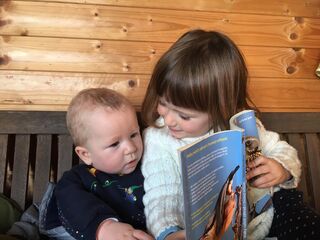Motivation
The Key Ingredients of Children’s Favorite Storybooks
Search for an optimal distance between children's and adults' perspectives.
Posted August 10, 2021 Reviewed by Chloe Williams
Key points
- It is no easy task to create a story that keeps both parents and children engaged when the same story often gets read and re-read every evening.
- Successful stories have an optimal distance between the reader and the story characters, which makes them relatable but they offer something new.
- Children tend to focus on the story characters, and adults tend to focus on the educational value of a story. Successful stories balance the two.
Children’s story reading is a popular activity in many families. It is also one of the most well-researched, and well-documented activities for children’s learning, so we know quite a lot about what works and what doesn’t. A successful reading session takes three to tango: the adult, the child and the book they read. It is the dynamic between all three that contributes to learning and creates a cozy reading atmosphere during a session.
Bedtime reading sessions are typically about favorite books that children want their parents to read again and again. A question I often get asked by children’s authors and illustrators is: Which features make up a child’s favorite book? And how can a child’s favorite book be their parent’s favorite book too? It is no easy task to keep the child and parent engaged when the same story gets read every evening! Authors need to inject elements into children’s favorite storybooks that appeal to both adults and children. The preferences can be individual but there are also some common trends.
What Do Parents and Children Like in a Story?
A good book goes through multiple drafts before it reaches the market. Authors share their ideas with prospective readers and make adjustments based on what their prospective readers say. In research, we are not interested in what works for one book but rather what might work for children’s stories more generally. This allows us to make some suggestions for existing stories, but also those that are not on the market yet.
In our recent study, we encouraged parents and children to reflect on the entire storytelling process, from the moment a story starts until it finishes. Is it the parent or the child who starts the session? What topics spark interest in a story? We also encouraged the families to make their own books, in any format they liked. Would they enjoy reading a story on a tablet or on paper?
What we found in this and other studies was surprising: It does not seem to be a particular theme or format of the storybook that the families like. It is how personal, or relatable, the story is to their own lives.
The Distance Between the Self and the Story
You can think of successful books as those that have an optimal distance between you, the reader, and them, the story characters. The story characters need to live in worlds that are relatable to the readers' own. At the same time, the story characters need to offer readers something new that expands their horizons. Such stories are of the highest learning value and they also engage children and parents most.
Reading is a unique context for experiencing this dual process of identification and immersion in a story but we should not underestimate the power of oral storytelling. Our observations at home and later workshops with designers and parents taught us the importance of oral storytelling for families.
Oral Storytelling
Telling a story from memory is extremely appealing to children and they enjoy parents making up their own stories, at times with prompts, at times without. It provides an opportunity to project emotions, find out about what preoccupies the child, and tailor the story to their interests. Storytelling does not need to remain at the verbal level. Stories can be captured visually or in an audio form with various story-making apps (for example, Our Story or StoryCreator). Hearing a story creates a unique theater of mind that lets the imagination run free. Photos and drawings, everyday objects or a recent shared experience, can be used as inspiration for family storytelling.

The Adults' and Children's Story Universe
The idea for a story starts from a common experience: something that scared the child, or something that made them happy or curious. But once the story is created, adults' and children's interests tend to diverge.
For children, the distance between self and other is about who the story characters are, how much they remind the children of their friends or other familiar others. Adults, on the other hand, tend to focus on the learning value of the story — how much it teaches children correct grammar or moral lessons. This is where it gets to the challenge of successful storybooks that appeal to the dual audience of adults and children, with their different expectations and goals for the reading session.
There is no formula for this. Each book has its own magic and will speak differently to parents and children. That is partly why a successful children’s book is an art form – it contains pictures (illustrations), text and ideas that bring together adults’ and children’s perspectives. With the current rich offer of story formats — from lift-the-flap books to digital stories with augmented reality and 3D animations – authors have a unique opportunity to enrich family lives with stories that shorten the distance between adults and children and reach their hearts with innovative book formats and story ideas.
References
Kucirkova, N. (2021). Distance. In The Future of the Self: Understanding Personalization in Childhood and Beyond. Emerald Publishing Limited.
Vasalou, A., Kalantari, S., Kucirkova, N., & Vezzoli, Y. (2020). Designing for oral storytelling practices at home: A parental perspective. International Journal of Child-Computer Interaction, 26, 100214.


